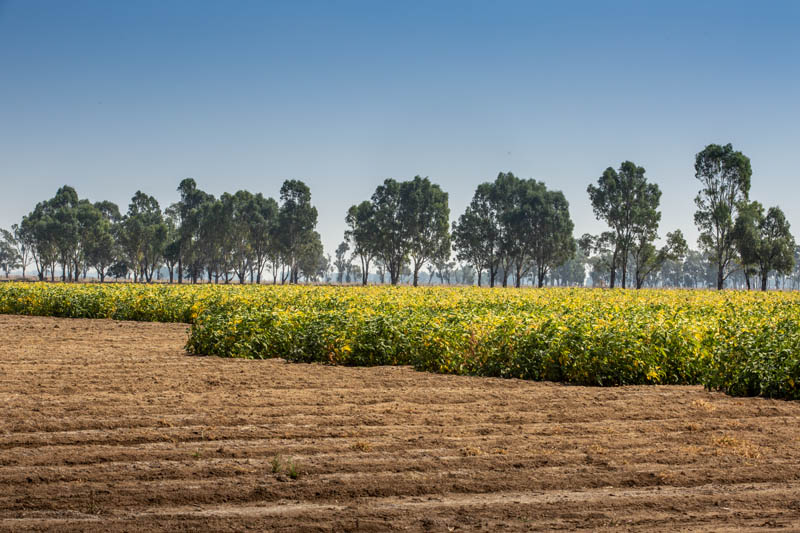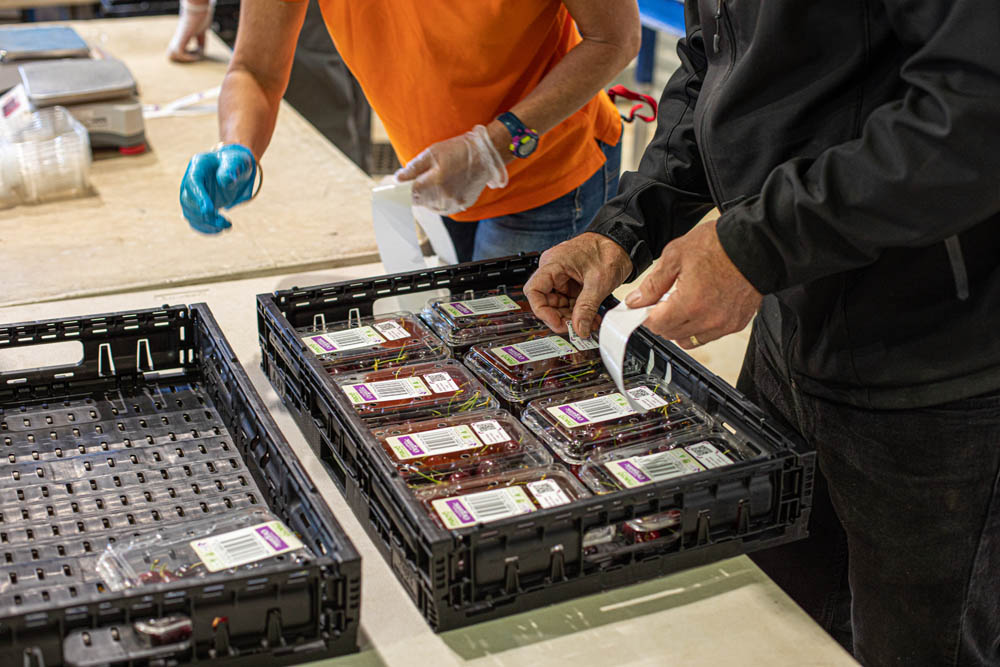- GVP $268 million est. Down 52% year-on-year.
- Chickpea production fell 62%.
- India is emerging as a key competitor in key Australian chickpea export markets.


Production
Chickpeas continued to be the dominant pulse crop in NSW however, production declined considerably, dropping 62% to 192,000 tonnes, the State’s smallest chickpea crop since 2019-20. 1 Seeded area was reported at 160,000 hectares, down 43% year-on-year. 1 Whilst the average state yield was 1.2t/ha, just under the 10-year average, widespread weather-affected quality downgrades and reports of mould, impacted many of the major NSW growing areas. Unseasonal late spring rains and widespread flooding across the Namoi and Gwydir Valleys (the State’s two largest chickpea growing regions) resulted in harvest delays and yield losses.
Following two years of high yielding crops and with many soils across the key cropping areas experiencing flooding or prolonged periods of saturation, soil nitrogen levels were reported to be low. 62 63 As faba beans leave more residual nitrogen after harvest than chickpeas, and in response to high urea and low chickpea prices, the estimated seeded area for faba beans increased 12% year-on-year. 64 Unfortunately, lower year-on-year average yields resulted in production falling to an estimated 81,000 tonnes, 19% less than last year. 1
Price
Sluggish global demand resulted from a massive increase in Indian domestic chickpea production. The average price for chickpea (delivered Junee) was $486/tonne, 4% lower year-on-year. 122 Wet harvesting conditions for a significant portion of the crop resulted in quality downgrades and impacted prices with reports of downgrades of up to $100/tonne at some sites for mould-impacted chickpeas. 66 Over the past few years, prohibitive freight rates and container shortages encouraged an increased number of bulk shipments of pulses which in the past, were typically containerised. This situation had eased to some degree by early 2023 however, some ongoing issues remained including rail and road inefficiencies, which made it difficult to get containers into Port Kembla and hindered current-crop sales, placing further pressure on prices. 42 Ramadan demand from South Asian markets during the final quarter of 2022 and the first quarter of 2023 provided a boost to prices over the spring and summer months amid more supportive exchange rates.
For lentils, the prospect of the large Australian domestic and Canadian lentil crops resulted in prices falling for lentils as well as chickpeas early in the season, limiting selling from growers. Combined with the uncertainty related to new crop quality and container availability, prices fell by up to $50/tonne in the months leading up to harvest. 72 73
Faba bean prices also struggled under the weight of supply arising from significant carry-over stocks from the record 2021-22 crop and a large new season crop. Lacklustre export demand put pressure on values early in the year however, strong demand from the stockfeed sector helped put a floor in prices.
Average field pea prices (delivered Junee) were 3% lower to $473/tonne compared to the previous year and lupin prices (delivered Junee) were relatively steady year-on-year at $424/tonne. 74
Trade and Macroeconomic Conditions
NSW Monthly pulse exports to Bangladesh, Pakistan, UAE and India 35
- Bangladesh
- India
- Pakistan
- United Arab Emirates
The Australia-India Economic Cooperation and Trade Agreement (AI-ECTA) was ratified by the Australian Parliament on 23 November 2022 and negotiations for a full free trade agreement commenced in 2023. This Agreement offers significant potential for Australian growers by eliminating or reducing tariffs on nearly 90% of Australian food and agricultural exports to India including immediate opportunities for barley, oats and lentils and over-time, faba beans. 72
Thailand relaced Egypt as the largest buyer for faba beans in 2022-23, 35 as currency difficulties resulted in only minimal quantities purchased by Egyptian importers. With another sizeable Australian domestic crop, carry-over stocks were considerable and despite robust domestic demand from stockfeed millers, the market struggled to absorb the volume of product. 73
Outlook
Demand for pulses remains positive, however ongoing credit issues in key markets such as Pakistan and Egypt may continue to impact export volumes.
Stronger Primary Industries Strategy
Paddock to supermarket traceability
Strategic Outcome

- 1.3 Rapidly and efficiently contain biosecurity threats

Digital solutions helping to trace food from paddock to plate
As consumers demand more transparency around what they are eating, NSW DPI is encouraging fresh food producers to use technology to track and trace a product’s journey from paddock to plate. Biosecurity incursions, food safety recalls or emergencies such as floods or bushfires need rapid responses to protect the supply chain and consumers but gathering this information takes time.
Until now, that is. A pilot study using GS1 data standards and a GS1 Digital Link QR code to create a digital map of products in the NSW cherry and potato industries has the potential to change that. Study results showed that using an integrated digital traceability system can improve industry competitiveness, buyer confidence and market access for horticultural products produced in NSW. In a new era of food security challenges, traceability provides transparency of a product’s provenance and where it is in the supply chain, providing consumers with confidence in a high-quality Australian product. By working with growers, the study improved understanding of what is required on-farm to enable traceability and what the benefits would be to others along the supply chain.
As part of the study, unique serialised QR codes with a GS1 Digital Link label were applied to Woolworths-branded brushed potatoes and organic cherries bags and punnets. The GS1 Digital Link was encrypted with location data and a scannable QR code, which led to an interactive consumer application that could be viewed on a smartphone. The GS1 Digital Link enabled the product to be traced in real-time, from property to store. It also provided information about how the product moved along the supply chain, the time spent at each location and allowed for real-time feedback from consumers. Capturing and sharing data at every point in the supply chain — growers, carriers, retailers and the government —can enable full trace-back and trace-forward visibility in real-time.
The pilot study was conducted in partnership with Woolworths, Food Agility CRC, Freshchain Systems, GS1 Australia, Mitolo Family Farms, Cantrill Organics and Cherry Growers Australia.


